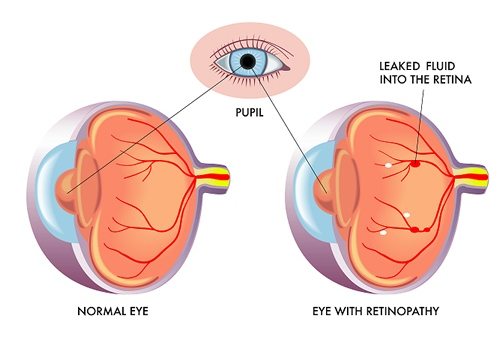Diabetic Retinopathy: Leading Cause of Preventable Blindness in America
Published onDiabetes is reported as the number one cause of blindness in America according to the American Diabetes Association. However, with proper steps and management what could result in vision loss could be only a minor to moderate vision impairment.
There are two terms to become familiar with: nonproliferative retinopathy and proliferative retinopathy. It is highly probable that everyone with type 1 diabetes and most people with type 2 diabetes will develop nonproliferative retinopathy. This does not mean that you will lose your sight, in fact many people only experience mild to moderate vision issues.

Nonproliferative Diabetic Retinopathy
Nonproliferative retinopathy, also known as background retinopathy, is when capillaries in the back of the eye balloon and form pouches. Although nonproliferative retinopathy usually does not require treatment, Macular Edema must be treated. This is caused by fluid leaking into the part of the eye where focusing occurs, the macula. When the macula swells with fluid, vision blurs and can be lost entirely. Fortunately, treatment is usually effective at stopping and sometimes reversing vision loss.
Proliferative Diabetic Retinopathy
Proliferative retinopathy is where the pouches close off the blood vessels and new vessels are formed but they are weak and can leak blood leading to vision loss. Also, scar tissue can form and cause retinal detachment. The sooner retinopathy is diagnosed the better the outcome is for saving ones sight. There are treatments and new procedures that have greatly improved reversing or reducing the loss of sight.

Other Eye Diseases That Affect People with Diabetes
There are other diseases of the eye that have a higher probability of affecting persons with diabetes verses those without diabetes. Cataracts are 60% more likely to affect a person with diabetes. Cataracts are likely to develop at a younger age and progress rapidly. Glaucoma is 40% more likely to affect a person with diabetes. The longer a person has had diabetes and the older a person is, the greater the risk for glaucoma to develop.
Act to Preserve or Retain Eyesight
The good news is you can control the outcome of successfully preserving your eyesight by being diligent in the following areas:
- Control your blood sugar by checking often and treating as prescribed by your doctor
- Keep your blood pressure under control
- Quit smoking
- See an eye care professional for a yearly exam with dilation

Contact Your Eye Care Professional If You Experience Any of These Symptoms:
- Vision becomes blurry
- Trouble reading signs or books
- Seeing double
- One or both eyes hurt
- Eyes get red and stay that way
- Feeling eye pressure
- Seeing spots or floaters
- Straight lines do not look straight
- Can’t see things on the sides (lowered peripheral vision)
Don’t become a statistic. Take action to prevent or reduce vision loss today. The future is yours.
More Eye and Vision Condition Resources
Categorized in: Health and Wellness, Informational
This post was written by



Comments are closed here.